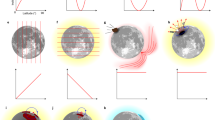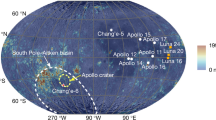Abstract
The lavas produced by historically recorded eruptions of Mt Vesuvius, and the Herculaneum mudflow resulting from the AD 79 eruption have been investigated archaeomagnetically. The mudflow carries a magnetically hard remanence, the direction of which is significantly different from that of the present-day field, suggesting that the remanence is primary. The secular variation curve for Vesuvius agrees well with the Rome record and with other curves from Italy and London. A model for westward drift which accounts for certain features of secular variation in Europe over the past 200 yr requires a mean deceleration rate of 0.004 deg yr−2. This is less than the current rate, suggesting that the deceleration rate was smaller 200 yr ago than it is today.
This is a preview of subscription content, access via your institution
Access options
Subscribe to this journal
Receive 51 print issues and online access
$199.00 per year
only $3.90 per issue
Buy this article
- Purchase on SpringerLink
- Instant access to full article PDF
Prices may be subject to local taxes which are calculated during checkout
Similar content being viewed by others
References
Principe, C. thesis, Univ. Pisa (1979).
Tanguy, J. C. Archaeometry 12, 115–128 (1970).
Aitken, M. J. Physics and Archaeology 2nd edn (Oxford University Press, 1974).
Games, K. P. Geophys. J. R. astr. Soc. 48, 315–329 (1977).
Harwood, J. M. & Malin, S. C. R. Nature 259, 469–471 (1976).
Tanguy, J-C. & Pozzi, J-P. C. r. hebd. Séanc. Acad. Sci. Paris 274, 352–354 (1972).
Bauer, L. A. Phys. Rev. 3, 34–48 (1899).
Brice, W., Imber, C., Lorch, R. & Pelham, P. Archaeometry 18, 228–229 (1976).
Lamoureux, C. & Klerkx, J. Ann. Soc. Geol. Belg. 90, 261–277 (1967).
Author information
Authors and Affiliations
Rights and permissions
About this article
Cite this article
Hoye, G. Archaeomagnetic secular variation record of Mount Vesuvius. Nature 291, 216–218 (1981). https://doi.org/10.1038/291216a0
Received:
Accepted:
Issue Date:
DOI: https://doi.org/10.1038/291216a0
This article is cited by
-
Lava identification by paleomagnetism: a case study and some problems surrounding the 1631 eruption of Mount Vesuvius, Italy
Earth, Planets and Space (2006)
-
Chronology of Vesuvius? activity from A.D. 79 to 1631 based on archeomagnetism of lavas and historical sources
Bulletin of Volcanology (2004)
-
Magnetic stratigraphy of Etan products. I-medieval lavas
Studia Geophysica et Geodætica (1996)
-
Spectral analysis of archaeomagnetic inclinations for the last 2000 years
Earth, Moon, and Planets (1989)



